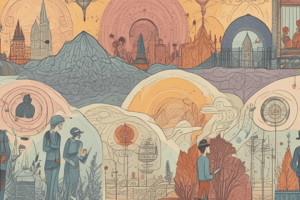Podcast
Questions and Answers
Why is gas exchange more efficient in smaller organisms?
Why is gas exchange more efficient in smaller organisms?
- Because they have a higher concentration of oxygen in their bodies
- Because they have a lower concentration of carbon dioxide in their bodies
- Because they have a faster heart rate
- Because they have a larger surface area to volume ratio (correct)
What is the function of the structure X in the respiratory tract?
What is the function of the structure X in the respiratory tract?
- To trap microorganisms
- To sweep dust particles towards the pharynx
- To trap large dust particles (correct)
- To sweep mucus towards the pharynx
What is the direction of oxygen diffusion during gas exchange in air sacs?
What is the direction of oxygen diffusion during gas exchange in air sacs?
- From the lungs to the air sacs
- From the air in the air sacs to the blood in capillaries (correct)
- From the air sacs to the lungs
- From the blood in capillaries to the air in the air sacs
Which part of the respiratory tract is not supported by cartilage?
Which part of the respiratory tract is not supported by cartilage?
What happens to carbon dioxide during gas exchange in air sacs?
What happens to carbon dioxide during gas exchange in air sacs?
Why is air inhaled through the nose cleaner than air inhaled through the mouth?
Why is air inhaled through the nose cleaner than air inhaled through the mouth?
What is the role of haemoglobin in gas exchange?
What is the role of haemoglobin in gas exchange?
Where does gas exchange take place in the body?
Where does gas exchange take place in the body?
What is the primary function of the pulmonary veins in the process of gas exchange?
What is the primary function of the pulmonary veins in the process of gas exchange?
What happens to oxygen in the air sac during the process of gas exchange?
What happens to oxygen in the air sac during the process of gas exchange?
What is the role of haemoglobin in the process of gas exchange?
What is the role of haemoglobin in the process of gas exchange?
What is the result of oxygen diffusing into the red blood cells?
What is the result of oxygen diffusing into the red blood cells?
What is the direction of carbon dioxide transport during gas exchange?
What is the direction of carbon dioxide transport during gas exchange?
What happens to carbon dioxide in body tissues where its concentration is high?
What happens to carbon dioxide in body tissues where its concentration is high?
What is the primary mechanism of gas exchange between the air sac and the capillary?
What is the primary mechanism of gas exchange between the air sac and the capillary?
What is the purpose of ventilation in the respiratory process?
What is the purpose of ventilation in the respiratory process?
What is the result of carbon dioxide diffusing out of the blood?
What is the result of carbon dioxide diffusing out of the blood?
What happens to hydrogencarbonate ions in the air sacs?
What happens to hydrogencarbonate ions in the air sacs?
What is the order of events during the process of gas exchange?
What is the order of events during the process of gas exchange?
What is the role of the intercostal muscles in the respiratory process?
What is the role of the intercostal muscles in the respiratory process?
What is the term for the process of bringing air into the lungs?
What is the term for the process of bringing air into the lungs?
What is the result of the rapid transport of respiratory gases by blood?
What is the result of the rapid transport of respiratory gases by blood?
What is the purpose of the reaction between carbon dioxide and water in red blood cells?
What is the purpose of the reaction between carbon dioxide and water in red blood cells?
What is the term for the flow of air into and out of the lungs?
What is the term for the flow of air into and out of the lungs?
Flashcards are hidden until you start studying
Study Notes
Respiratory System
- Gas exchange across the body surface is more efficient in smaller organisms than in larger organisms.
- Air inhaled through the nose is cleaner than air inhaled through the mouth.
Inner Wall of the Trachea
- Structure X (not specified) traps large dust particles, microorganisms, and sweeps dust particles towards the pharynx.
Gas Exchange in Air Sacs
- Gas exchange takes place in air sacs where oxygen diffuses from the air into the blood in capillaries, while carbon dioxide diffuses in the opposite direction.
- In body tissues with high carbon dioxide concentration, carbon dioxide diffuses into red blood cells, reacts with water to form hydrogencarbonate ions and hydrogen ions.
- Hydrogencarbonate ions diffuse out of red blood cells and are carried by plasma to the air sacs.
- In air sacs with low carbon dioxide concentration, hydrogencarbonate ions in plasma diffuse into red blood cells, reacting with hydrogen ions to form carbon dioxide and water.
Ventilation
- Ventilation is the flow of air into and out of the lungs, helping maintain a steep concentration gradient between air sacs and the blood in surrounding capillaries.
- Ventilation is brought about by breathing actions, including inhalation (inspiration) and exhalation.
- Inhalation causes the rib cage to move upwards and outwards, bringing air into the lungs.
- Mechanism of inhalation: intercostal muscles contract, causing the rib cage to move upwards and outwards, and air is inhaled into the lungs.
Studying That Suits You
Use AI to generate personalized quizzes and flashcards to suit your learning preferences.



